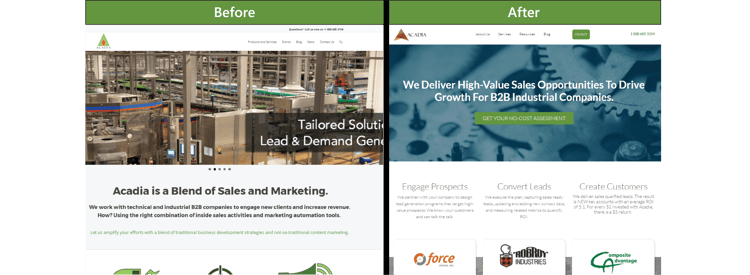
If you'd asked me four months about my knowledge of industrial website design, I most likely wouldn't have had much to say. I had experience in B2C web design, and I thought that it would be similar, but I realized quickly that B2B websites were an entirely different breed. Here I've put together 8 tips I learned from designing Acadia's new website and what you can do to ensure that your project runs smoothly.
- Plan Before You Build.
Like every large project, proper planning is a must. Before you even begin to think about design or content, set aside time to do thorough research. This includes researching competitors, keywords, and web design best practices. It may also be helpful to interview current customers about gaps in your current site and what they like, and dislike. Ask yourself about the goals for your new site, and set a strategy that aligns with that prior to jumping into any writing of content and designing of pages. One useful tip I learned the hard way is to plan out a written draft of each page before actually building it. This will save time and many, many visits to your pages. If you're hiring an agency to help you, be sure they schedule time for this important work. - Less is more.
The main goal for Acadia's redesign was to clearly express our message to visitors and to make our site easier to navigate. That's why we focused strenuously on simplifying our message and a lot of our content. You want your visitors to visit your page and, in a few moments, be able to understand what exactly you do and how it can help them. Less content and a simplified message means literally fewer words, too. A lot of my work was condensing paragraphs of content into just a few lines. Another tip: don’t feel pressured to fill in all the whitespace. As a matter of fact, whitespace is a very valuable element of design.
- Hone your message, and maybe even your services.
Achieving a simplified message requires hours of revisiting your mission and what exactly you can offer your visitors that sets you apart from your competition. Not only will it be tough to simplify your message down into just a few words, which I will speak to in #5, but it will have you asking yourself, "what exactly does my business do best?" and "what is the ultimate goal of my business?" It may be helpful to revisit your business strategy and be sure that your website reflects that. Put on the hat of your visitor and look at your homepage with new eyes. Is it clear what you offer? Would it be that way to a stranger? Look at where you are redundant and make each page unique. - Don't talk about yourself, but talk to your website visitors.
One step that should be included in your plan and research should be deciding who your ideal customer is and what problems of theirs you can solve. You want to design your site around what they need to hear and how you can solve their problems in language that is meaningful to them, not necessarily your industry jargon. I suggest displaying your results front and center on your site so visitors see your impacts on companies like theirs. Identifying and understanding your ideal customer can often reshape your messaging considerably. Images are a critical part of your website, so be sure to identify pictures and infographics your prospects will find compelling. - Have fun with the process, but keep in mind it's difficult.
Again, creating a simplified message also requires less words. Taking 40 words and distilling them to 7-8 was challenging. Writing a “hook” for each page required patience and many iterations. One of the biggest challenges was making sure the language and structure on each page "felt the same way," but also was new and unique content. You'll also want your site to look nice and uniform, organized and clean, so make sure each page flows into the next and that your content isn't too wordy. - Take the time to get everything “just so”, but don't let it frustrate you.
There are many, many details that go into one webpage. Formatting, setting headers, writing meta descriptions and getting images just right are just a few of them, and is a lesson in patience. Keeping track of what pages contain what content can also be a struggle, so use a tool to house that information. Set formatting for each page in terms of font, size, justification, etc. before uploading content. Another tip we learned the hard way: make sure to shrink images before you upload and create alt-text immediately. You don't want to have to go back and touch each page 42 times. Lastly, remember to reroute your old URLs to your simplified or new pages so the SEO work you've done to date doesn't get lost in the shuffle. - Give yourself a buffer for go live in case there are any major problems and test, again and again.
Another lesson often learned the hard way: don’t pick a Friday for go live as your web technical support is likely not working over the weekend. We found it helpful also to go live the end of the day, after 5pm and publish backward from landing pages to the homepage. That way, you work through any problems before your homepage goes live. Before go live, test each link and reference and set a plan with your team for testing and launch. This includes all links on landing pages and emails, as well. Once the site is up, test again and have others do the same. It may be smart to get some fresh eyes, like those of your co-workers and advocates. Have a shared document where these users can log any bugs. Don’t officially announce that you are live until you are 101% sure it’s complete and running smoothly. - Don't skimp on the About Us page.
I think any company owner would say that their biggest asset is their team. I muddled around from page to page, seemingly stuck in my thinking. It was not until the "About Us" page was put together did I have the plan for the rest of the website, including the homepage. Don't underestimate how important this page is. In a world of commodities, your team and your values can set you apart from your competition. Have fun with this page to really let the personality of your company shine.
Redesigning a website takes time and is no walk in the park, but it can be a fun and fulfilling project and give your company an exciting way to take stock of its strengths. Remember that it's not a "one and done" type of project. Always dynamic, your new website should be looked at as a tool among many to bring visibility to your company.
Take a moment to visit our new website.
And let us know what you think in the comments below. Subscribe to our blog above to stay informed about how to be visible to your prospects when they are ready to buy.







Comments